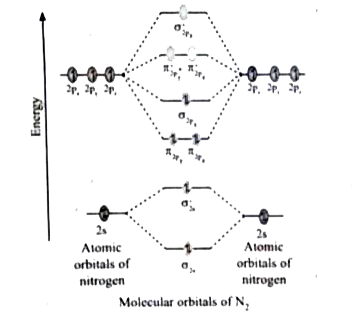Complete Solutions to TEXTUAL EVALUATION SOLVED (SHORT ANSWER QUESTIONS.) of chapter CHEMICAL BONDING of Class 11 book with complete answers and questions
| Class 11 | CHEMISTRY |
| Chapter | CHEMICAL BONDING |
| FULL MARKS | TEXTUAL EVALUATION SOLVED (SHORT ANSWER QUESTIONS.) |
| Number Of Questions | 25 |
| Academic Year | 2023-24 |
Define the following: (i) Bond order (ii) Hybridisation (iii) `sigma` -bond
View SolutionWhat is a pi bond ?
View SolutionIn `CH_(4),NH_(3) " and " H_(2)O` the central atom undergoes `sp^(3)` hybridlsation - yet their bond angles are different.
View SolutionExplain `sp^(2)` hybridisation in `BF_(3)`.
View SolutionDraw the M.O diagram for oxygen molecule calculate its bond order and show that `O_(2)` is paramagnetic.
View SolutionDraw MO diagram of CO and calculate its bond order .
View SolutionWhat do you understand by interphase ?
View SolutionDiscuss the formation of N2, molecule using MO Theory.

View SolutionWhat is dipole moment ?
View SolutionLinear form of carbondioxide molecule has two polar bonds. Yet the molecule has zero dipole moment why?
View SolutionDraw the Lewis structures for the following species.
`HNO_(3)`
View SolutionExplain the bond formation in `BeCl_(2) and MgCl_(2).`
View SolutionWhich bond is stronger `sigma or pi`? Why ?
View SolutionDefine bond energy.
View SolutionHydrogen gas is diatomic where as inert gases are monoatomic - explain on the basis of MO theory.
View SolutionWhat is polar covalent bond? Explain with example.
View SolutionConsidering x-axis as molecular axis, which out of the following will form a sigma bond.
(i) `1s and 2p_(y)`
(ii) `2p_(x)and 2p_(x)`
(iii) `2p_(x)and 2p_(z)`
(iv) `1s and 2p_(z)`
View SolutionExplain resonance with reference to carbonate ion.

Lewis structure of `CO_(3)^(2-)`
View SolutionExplain the bond formation in ethylene and acetylene.
View SolutionWhat type of hybridisations are possible in the following geometeries ?
(a) octahedral
(b) tetrahedral
(c ) square planar
View SolutionExplain VSEPR theory . Applying this theory to predict the shapes of `IF_(7)`, and `SF_(6)`.
View Solution`CO_(2) and H_(2)O` both are triatomic molecules but their dipole moment values are different. Why?
View SolutionWhich one of the following has highest bond order? `N_(2), N_(2)^(+) or N_(2)^(-)`?
View SolutionExplain the covalent character in ionic bond.
View SolutionDescribe fajan's rule.
View Solution
TEXTUAL EVALUATION SOLVED (SHORT ANSWER QUESTIONS.) questions and complete solutions for chapter CHEMICAL BONDING of FULL MARKS CHEMISTRY (TAMIL ENGLISH) of Class 11
All Exercises from FULL MARKS Class 11 CHEMISTRY CHEMICAL BONDING
- ADDITIONAL QUESTIONS SOLVED (2-MARK QUESTIONS)
- ADDITIONAL QUESTIONS SOLVED (3-MARK QUESTIONS)
- ADDITIONAL QUESTIONS SOLVED (5-MARK QUESTIONS)
- ADDITIONAL QUESTIONS SOLVED (ASSERTION AND REASON.)
- ADDITIONAL QUESTIONS SOLVED (CHOOSE THE CORRECT ANSWER.)
- ADDITIONAL QUESTIONS SOLVED (CHOOSE THE CORRECT PAIR)
- ADDITIONAL QUESTIONS SOLVED (CHOOSE THE CORRECT STATEMENT)
- ADDITIONAL QUESTIONS SOLVED (CHOOSE THE INCORRECT PAIR.)
- ADDITIONAL QUESTIONS SOLVED (CHOOSE THE ODD ONE OUT.)
- ADDITIONAL QUESTIONS SOLVED (FILL IN THE BLANKS.)
- ADDITIONAL QUESTIONS SOLVED (MATCH THE FOLLOWING.)
- IN TEXT QUESTION-EVALUATE YOURSELF
- TEXTUAL EVALUATION SOLVED (MULTIPLE CHOICE QUESTIONS.)
- TEXTUAL EVALUATION SOLVED (SHORT ANSWER QUESTIONS.)